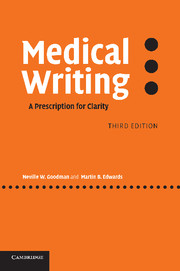Book contents
- Frontmatter
- Contents
- Preface to the first edition
- Preface to the third edition
- Acknowledgements
- PART I PROBLEM: THE ILLNESS
- PART II SOLUTION: SYMPTOMATIC RELIEF
- PART III PRACTICE: RECUPERATION
- 16 Some examples rewritten
- 17 Do the experts agree?
- Appendix: examples to rewrite
- References and further reading
- Index
16 - Some examples rewritten
Published online by Cambridge University Press: 23 November 2009
- Frontmatter
- Contents
- Preface to the first edition
- Preface to the third edition
- Acknowledgements
- PART I PROBLEM: THE ILLNESS
- PART II SOLUTION: SYMPTOMATIC RELIEF
- PART III PRACTICE: RECUPERATION
- 16 Some examples rewritten
- 17 Do the experts agree?
- Appendix: examples to rewrite
- References and further reading
- Index
Summary
Writing improves with practice.
All the following examples need rewriting. Most contain words or phrases commonly used in poor writing, discussed in earlier sections of this book. We indicate these ‘marker’ words or phrases, and any style fault if appropriate, after each example. Example 1 is invented, all the others are taken from medical books or journals. Some of the passages have been modified slightly to make them more generally understandable but the modifications have not altered the constructions.
If you wish to test yourself with these examples, without seeing our suggestions for rewriting, then turn to the Appendix, where the examples are reproduced without the rewrites.
Example 1
In the case of this particular elderly patient hypertensive population, reduction of blood pressure by 18/11 mmHg was achieved for a mean duration of follow up period of 4.4 years. However, with regard to overall mortality, there was no effect nor was there any effect on the incidence of occurrence of myocardial infarction, whether of fatal or non-fatal nature. With respect to cardiovascular accidents, a reduction in incidence of 42% was encountered, and this was mainly associated with strokes leading to fatality or serious neurological sequelae. Although it was not significant, cardiovascular mortality was shown to be reduced by 22%.
Markers: IN THE CASE OF, ACHIEVED, HOWEVER, WITH REGARD TO, NATURE, WITH RESPECT TO, ENCOUNTERED, ASSOCIATED WITH, FATALITY, WAS SHOWN TO BE
Style fault: CIRCUMLOCUTION, PASSIVE, NOUNS AS ADJECTIVES, REPETITION
Comment: Many of the words and phrases are superfluous or are substitutions for simpler words.
- Type
- Chapter
- Information
- Medical WritingA Prescription for Clarity, pp. 205 - 228Publisher: Cambridge University PressPrint publication year: 2006



